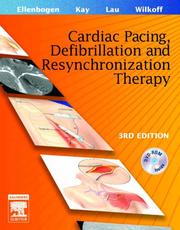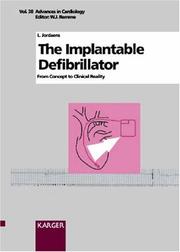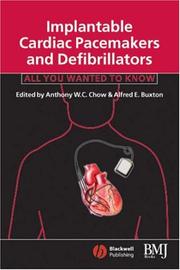| Listing 1 - 10 of 28 | << page >> |
Sort by
|
Book
Year: 2006 Publisher: Bruxelles: UCL,
Abstract | Keywords | Export | Availability | Bookmark
 Loading...
Loading...Choose an application
- Reference Manager
- EndNote
- RefWorks (Direct export to RefWorks)
Since March 1990, the Univerity clinics of Mont-Godinne propose the implantation of an automatic defibrillator. This treatment is intended to the patients whose tachyarrhythmia resists the traditional treatments, that they are medicamentous, surgical or that they are radiofrequency ablation. Moreover, since 1996 the implantable defibrillator is proposed in a prophylactic way to patients who suffer from arrhythmogenic congenital diseases to knowing the Brugada syndrome and the long QT syndrome.
Among this implanted patients, 133 were included in this study with an average follow-up time of 54.7 months. Three series of survival analysis were carried out. The three followed events were : the cardiac death, the occurrence of the ventricular lead dysfunction and the occurrence of the first electric shock delivered by the device. For each analysis series, the patients were divided according to various factors (age, coronary pathology, indication, left ventricular ejection fraction, mark and model of the ventricular lead). The survival curves were then compared by the Log-rank test.
In the survival analysis being interested in the cardiac death one observes a survival at 5 years of 74.8%. Several factors appeared discriminating. Thus the survival curves are different according to whether the patients had more or less than 60years at the time of the implantation (p-value 0.042), according to whether one suffers or not from a coronary pathology (p-value 0.035) and according to whether the defibrillator was implanted for prophylactic reasons (genetic disease) or for an history of ventricular tachyarrhythmia’s (p-value0.0033). No significant difference (p-value 0.451) was noted about ventricular lead dysfunction according to the mark (Medtronic and CPI-Guiding). However it was observed that 18.5% of the only model “Sprint 6943-65” (Medtronic) were fractured. No discriminating factor showed difference in the occurrence of the first electric shock delivered by the device.
In conclusion, one could show that, among implanted patients of an automatic defibrillator, survival was influenced by coronary pathology. The study did not show any difference in the occurrence of a ventricular lead dysfunction according to the mark. Nevertheless, only the model “Sprint 6943-65” of the Medtronic mark knew events of fracture. The last series of survival analysis has, as for it, shown that the group of patients established for prophylactic reasons (Brugade syndrome and long QT syndrome) precociously received electric shocks of defibrillation by the automatic system. This last observation indicates that the presence of arrhythmogenic genetic diseases is an indication to implant this device Depuis mars 1990, les Cliniques Universitaires de Mont-Godinne proposent l’implantation d’un défibrillateur cardiaque automatique. Ce traitement est destiné aux patients dont la tachyarythmie résiste aux traitements traditionnels, qu’ils soient médicamenteux, chirurgicaux ou qu’il s’agisse d’ablation par radiofréquence des foyers responsables de l’arythmie. En outre, depuis 1996 le défibrillateur cardiaque implantable est proposé de façon prophylactique à des patients atteints de maladies congénitales arythmogènes à savoir le syndrome de Brugada et la syndrome du QT long.
Parmi les patients implantés, 133 ont été inclus dans cette étude avec un temps de suivi moyen de 54.7 mois. Trois séries d’analyse de survie ont été réalisées. Les trois événements suivis ont été : le décès d’origine cardiaque, la survenue d’un dysfonctionnement de la sonde ventriculaire et la survenue du premier choc électrique délivré par le dispositif. Pour chaque série d’analyse les patients ont été répartis selon divers facteurs (âge, pathologie coronaire, type d’indication, fraction d’éjection ventriculaire gauche, marque et modèle de la sonde ventriculaire). Les courbes de survie ont ensuite été comparées par le test du logrank.
Dans l’analyse de survie s’intéressant au décès d’origine cardiaque on observe une survie à 5 ans de 74.8%. Plusieurs facteurs se sont révélés discriminants. Ainsi les courbes de survie sont différentes selon que l’on ait plus ou moins de 60 ans lors de l’implantation (p-value 0.042), selon que l’on souffre ou non d’une pathologie coronaire (p-value 0.035à et selon que le défibrillateur ait été implanté pour des raisons prophylactiques (maladies génétiques) ou pour des antécédents de tachyarythmie ventriculaire (p-value 0.033). Aucune différence significative (p-value 0.451) n’a été constatée au sujet du dysfonctionnement de sonde ventriculaire selon la marque (Medtronic et CPI-Guidant). Cependant il a été observé que 18.5% du seul modèle « Sprint 6943-65 » de la marque Medtronic se sont fracturées. Aucun facteur discriminant n’a mis en évidence de différence dans la survenue du premier choc électrique délivré par le dispositif.
En conclusion, on a pu montrer que, chez les patients implantés d’un défibrillateur cardiaque automatique, la survie était influencée par la pathologie coronaire. L’étude n’a pas mis en évidence de différence dans la survenue de dysfonctionnement de sonde ventriculaire selon la marque. Néanmoins, seul le modèle « Sprint 6943-65 » de la marque Medtronic a connu des événements de fracture. La dernière série d’analyse de survie a, quant à elle, montré que le groupe de patients implanté pour des raisons prophylactiques (syndrome du Brugada et de QT long) recevait précocement des chocs électriques de défibrillation par le système automatique. Cette dernière observation indique que la présence de maladies génétiques arythmogènes est une indication d’implantation du dispositif
Book
ISBN: 9781119578352 1119578353 1119578280 111957837X Year: 2020 Publisher: Hoboken, NJ : Wiley Blackwell
Abstract | Keywords | Export | Availability | Bookmark
 Loading...
Loading...Choose an application
- Reference Manager
- EndNote
- RefWorks (Direct export to RefWorks)
Cardiac Pacing, Artificial --- Defibrillators, Implantable --- Pacemaker, Artificial

ISBN: 9781437710663 1437710662 9781416025368 1416025367 Year: 2007 Publisher: Philadelphia : Saunders/Elsevier,
Abstract | Keywords | Export | Availability | Bookmark
 Loading...
Loading...Choose an application
- Reference Manager
- EndNote
- RefWorks (Direct export to RefWorks)
This 3rd edition presents cutting-edge standards of pacing and defibrillation to keep you at the forefront of this rapidly expanding field. You'll find coverage of all the new devices and management strategies you need to solve a full range of clinical problems using today's best approaches. Written by world authorities on pacing and devices for cardiac care, this new full-color 3rd edition is the more practical than ever!Addresses the management of patients with a broad range of conditions, including sinus node disease, carotid sinus hypersensitivity, tachyarrhythmias, heart failure,
Cardiac pacing. --- Defibrillators. --- Cardiac Pacing, Artificial. --- Defibrillators, Implantable. --- Pacemaker, Artificial.
Dissertation
ISBN: 9039316562 Year: 1998 Publisher: S.l. s.n.
Abstract | Keywords | Export | Availability | Bookmark
 Loading...
Loading...Choose an application
- Reference Manager
- EndNote
- RefWorks (Direct export to RefWorks)
Electrocardiography --- Cardiac Pacing, Artificial --- Defibrillators, Implantable --- Ventricular Fibrillation --- methods --- etiology

ISBN: 3805562217 9783805562218 Year: 1996 Volume: 38 Publisher: Basel: Karger,
Abstract | Keywords | Export | Availability | Bookmark
 Loading...
Loading...Choose an application
- Reference Manager
- EndNote
- RefWorks (Direct export to RefWorks)

ISBN: 9780727915665 0727915665 Year: 2006 Publisher: Malden, Mass. : Blackwell Pub./BMJ Books,
Abstract | Keywords | Export | Availability | Bookmark
 Loading...
Loading...Choose an application
- Reference Manager
- EndNote
- RefWorks (Direct export to RefWorks)
Cardiac Pacing, Artificial. --- Defibrillators, Implantable. --- Pacemaker, Artificial. --- Cardiac pacing. --- Electric countershock --- Coeur --- Défibrillation --- Stimulation
Dissertation
ISBN: 9052782709 Year: 2000 Publisher: Maastricht Universitaire pers
Abstract | Keywords | Export | Availability | Bookmark
 Loading...
Loading...Choose an application
- Reference Manager
- EndNote
- RefWorks (Direct export to RefWorks)
Atrial Fibrillation --- Defibrillators, Implantable --- Heart Conduction System --- Atrial Flutter --- therapy --- physiopathology
Periodical
Abstract | Keywords | Export | Availability | Bookmark
 Loading...
Loading...Choose an application
- Reference Manager
- EndNote
- RefWorks (Direct export to RefWorks)
Arrhythmia --- Cardiac pacing --- Electrophysiology --- Arrhythmias, Cardiac --- Cardiac Pacing, Artificial --- Anti-Arrhythmia Agents --- Defibrillators, Implantable
Dissertation
ISBN: 9052783055 Year: 2001 Publisher: Maastricht Universitaire pers
Abstract | Keywords | Export | Availability | Bookmark
 Loading...
Loading...Choose an application
- Reference Manager
- EndNote
- RefWorks (Direct export to RefWorks)
Atrial Flutter --- Arrhythmias, Cardiac --- Cardiac Pacing, Artificial --- Defibrillators, Implantable --- Ventricular Fibrillation --- diagnosis --- therapy --- methods
Dissertation
ISBN: 9789036739986 Year: 2009 Publisher: Enschede Gildeprint
Abstract | Keywords | Export | Availability | Bookmark
 Loading...
Loading...Choose an application
- Reference Manager
- EndNote
- RefWorks (Direct export to RefWorks)
Atrial Fibrillation --- Defibrillators, Implantable --- Electric Injuries --- Heart Failure --- prevention & control --- adverse effects --- therapy
| Listing 1 - 10 of 28 | << page >> |
Sort by
|

 Search
Search Feedback
Feedback About UniCat
About UniCat  Help
Help News
News